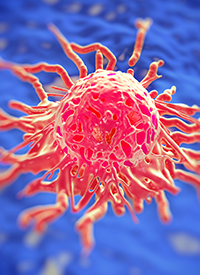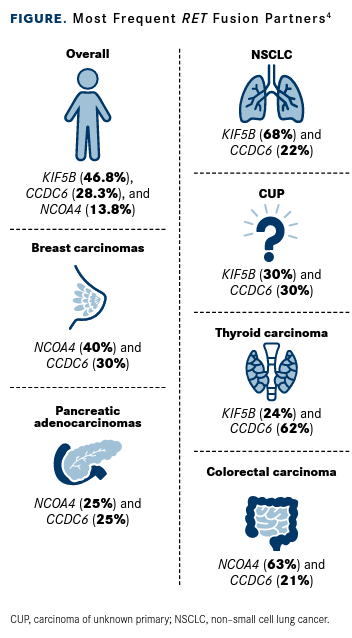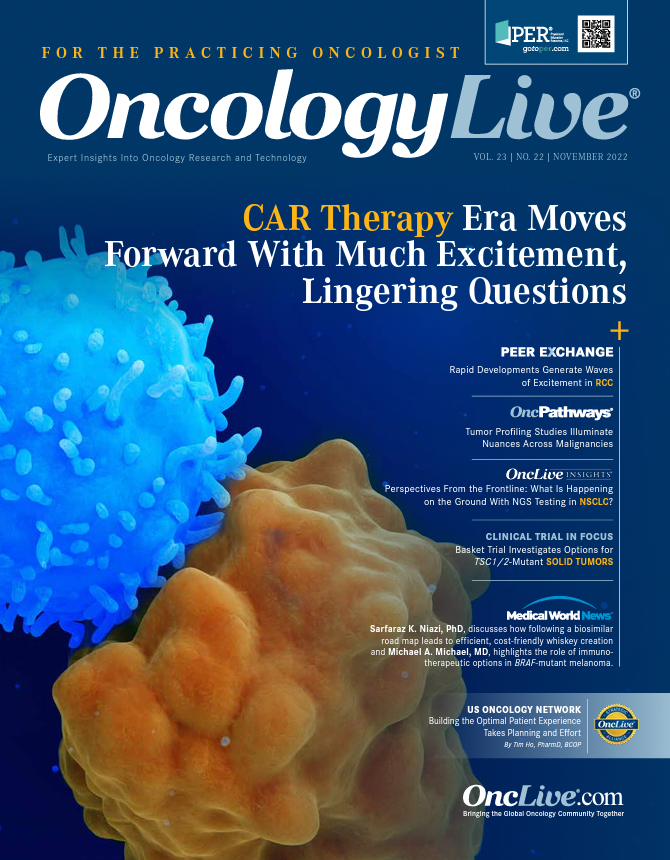Publication
Article
Tumor Profiling Studies Illuminate Nuances Across Malignancies
Author(s):
Molecular and immune landscapes for solid tumors are constantly evolving as precision medicine techniques become more sensitive and next-generation sequencing methods are taken up in clinical practice.

Molecular and immune landscapes for solid tumors are constantly evolving as precision medicine techniques become more sensitive and next-generation sequencing methods (NGS) are taken up in clinical practice.
Posters presented at the European Society for Medical Oncology Annual Congress 2022, showcased the results of the latest investigative efforts across institutions to better elucidate prevalent mutations across tumor types, some of which may inform next steps in drug development.
Colorectal Carcinoma and RET Fusions
RET fusions in solid tumors are most prevalent in non–small cell lung cancer (NSCLC) and well-differentiated thyroid cancer with 2 selective RET tyrosine kinase inhibitors (TKIs)—selpercatinib (Retevmo) and pralsetinib (Gavreto)—approved for the treatment of patients with these indications.1,2 Additionally, in September 2022, an accelerated approval was granted to selpercatinib for the treatment of patients with locally advanced or metastatic solid tumors with a RET gene fusion.3
Investigators conducted a retrospective analysis using targeted RNA sequencing as well as whole transcriptome sequencing to identify the distribution of RET-positive solid tumors by cancer type and evaluate their molecular characteristics.
Malignancies examined were NSCLC (n = 253), thyroid (n = 42), colorectal (n = 38), breast (n = 10), carcinoma of unknown primary (CUP; n = 10), and pancreatic (n = 8). Per cancer type, the distribution of RET-positive tumors were 66.9%, 11.1%, 10.1%, 2.6%, 2.6%, and 2.1%, respectively. Thyroid and breast RET-positive tumors were carcinomas whereas colorectal and pancreatic were adenocarcinomas.4
Additional RET-positive tumors examined included anaplastic thyroid carcinoma, cholangiocarcinoma, liver hepatocellular carcinoma, melanoma, neuroendocrine tumors, ovarian, soft tissue tumors, glioblastoma, and salivary gland tumors.
Pathogenic/likely pathogenetic comutations occurring at a rate of more than 10% were NGS-TP53, NGS-RASA1, NGS-LOH, and NGS-ARID1A. Coamplifications with a copy number more than 6 were Can (copy number alteration)-MDM2 (3.7%), CNA-MYC (2.5%), and CNA-CDK4 (2.0%).
Most Frequent RET Fusion Partners

Overall, the most frequent RET fusion partners were KIF5B (46.8%), CCDC6 (28.3%), and NCOA4 (13.8%). By malignancy, the most prevalent were KIF5B (68%) and CCDC6 (22%) in NSCLC, NCOA4 (40%) and CCDC6 (30%) in breast carcinomas, KIF5B (30%) and CCDC6 (305) in CUP, NCOA4 (25%) and CCDC6 (25%) in pancreatic adenocarcinomas, NCOA4 (24%) and CCDC6 (62%) in thyroid carcinoma, and NCOA4 (63%) and CCDC6 (21%) in colorectal adenocarcinomas (Figure).4
Investigators identified a total of 378 RET-positive solid malignancies in 15 different tumor types and CUP to undergo next-generation RNA sequencing. The most frequent single gene alterations in RET-positive tumors were TP53 (34.8%), ARID1A (10.8%) and RNF43 (6.7%). Additionally, colorectal cancer RET-positive tumors had a median tumor mutational burden (TMB) of 20 Mt/Mb with microsatellite instability high (MSI-H) seen in 63%.
Frequency of ROS1 Fusions in Solid Tumors
A pan tumor analysis was performed on ROS1 fusions across all solid tumors and the retrospective analysis used targeted RNA sequencing or whole transcriptome sequencing to identify the ROS1 fusion positive–solid malignancies.5
The analysis included 259 ROS1-positive tumors in NSCLC (n = 204), glioblastoma (n = 18), breast (n = 7), and others (n = 30). The other category included pancreatic adenocarcinoma, cancer of unknown primary, cholangiocarcinoma, gastric adeno, colorectal adeno, soft tissue, bladder, melanoma, neuroendocrine, ovarian, and thyroid.
Fusion partners in all the ROS1-positive solid tumors included CD74 (29.03%), EZR (21.29%), SLC34A2 (15.48%), SDC4 (11.29%), GOPC (9.03%), and 28 different partners occurred at a rate of under 2%.
The frequency of fusion breakpoint by ROS1 exons was E6 (24.52%), E13 (11.94%), E10 (11.61%), E2 (10.97%), E9 (9.68%), E8 (7.74%), E4 (6.13%), intron 4 (4.19%), E7 (2.90%), E1 (2.58%), and 11 different exons occurred at a rate of under 2%.
The mean TMB was 4.8 Mt/Mb (SD, 2.8) for all ROS1+ tumors. TMB was 5.7 Mt/Mb (SD, 3.4) in NSCLC, 3.6 Mt/Mb (SD, 1.5) in glioblastoma, and 5.7 Mt/Mb (SD, 3.6) in breast.
The most prevalent coalterations for NSCLC identified by NGS were LOH (7.3%) or mutations in TP53 (29.1%) and SETD2 (7.3%). In glioblastoma the most common were PTEN (29.4%), PIK3CA (17.6%), and TP53 (12.5%). The most frequent in breast cancer tumors were TP53 (85.7%) and ERBB2 (28.6%). Using immunohistochemistry, estrogen receptor, progesterone receptor, and HER2 status was reported in 33.3% of tumors.5
Investigators concluded that ROS1 fusions occurred at a low frequency in the 17 solid malignancies identified from 259 ROS1-positive tumor samples out of 175,350 tumors that underwent sequencing. Of the ROS1-positive solid malignancies, 78.8% were in NSCLC, 6.9% in glioblastoma, 2.7% in breast. There are 2 ROS1 TKIs approved for ROS1-positive in NSCLC—crizotinib (Xalkori) and entrectinib (Rozlytrek).6,7
Additionally, ROS1 fusions occurred at an approximate frequency of 0.47% for NSCLC, 0.29% for glioblastoma and 0.04% for breast cancer. It was also noted that ROS1-positive in glioblastoma may represent a potential poor prognostic factor (HR, 0.56; 95% CI, 0.23-1.35; P = .19).5
Response With Adjuvant Nivolumab in Recurrent HNSCC
Although salvage therapies are advancing,outcomes for patients with head and neck squamous cell carcinoma (HNSCC) remain poor. Investigators retrospectively examined findings phase 2 trial (NCT03355560) of adjuvant nivolumab (Opdivo) after salvage resection to characterize the molecular and immune landscape of patients with HNSCC.8
NGS, WTS, and whole-exome sequencing (WES) were performed on 37 tumors and the TMB cutoff was at least 10 Mt/Mb. Molecular alteration rates by sites, the larynx (n = 14), oral cavity (n = 10), and oropharynx (n = 7), were examined. Tumors with TP53 mutations occurred 86% in the larynx and 100% in the oral cavity and PIK3CA mutations were solely found in the oropharynx at a rate of 57%. P16 mutations occurred in the larynx (8%) and the oropharynx (86%).
Gene expression for ABCA prior chemotherapy relative to no chemotherapy had a relative frequency (log) of –1.4 and a false discovery rate of 6.1. Gene expression for SNRPFP1 for TMB-high vs TMB-low had a relative frequency (log) of 1.1 with a false discovery rate of 5.6. Further, gene expression for well differentiated vs not well differentiated had a relative frequency (log) of 1.4 for both the SEMA3G and HS3ST6 genes and the false discovery rate was 2.0 and 2.7, respectively.8
Distinct immune cell abundance and molecular alterations were not found in patients treated with nivolumab who developed a relapsed disease (n = 11) and those who did not (n = 26). In relation to immune cell abundance, gender, TMB-high status, and secondary disease had no significant findings. In relation to molecular alterations, the previous groups were not significant in addition to the following comparison groups: prior treatment of chemoradiation therapy vs radiation therapy alone, PD-L1 positivity, tumor differentiation, type of prior chemotherapy with cisplatin vs cetuximab, and secondary disease.
The authors concluded that larger prospective trials are needed to further examine recurrent HNSCC cancers and analyze molecular and immune profiles on subgroups as they were unable to find a clear marker to predict responses to adjuvant nivolumab.8
Immune-Cold Patterns Observed in HRAS-Mutated NSCLC
As RAS pathway alterations in NSCLC remain a difficult therapeutic target, investigators analyzed 29,767 NSCLC tumor tissue samples to examine the relationship between HRAS gene mutations and the tumor microenvironment (TME). In head and neck tumors, HRAS has been notably inactive because of indirect targeting with the farnesyltransferase inhibitor, tipifarnib. However, the role of HRAS is unclear in NSCLC although KRAS has been associated with immune modulation.9
Tumor tissue samples were molecularly profiled using NGS of DNA, RNA, and immunohistochemistry. Of the 29,767 samples, 0.4% (n = 128) had HRAS mutations with most being from smokers.
Presence of HRAS mutations were linked to worse prognosis for patients who received pembrolizumab (Keytruda; HR, 1.667; 95% CI, 0.921-3.017; P = .088). Patients also displayed less B cell macrophage M2, natural killer cell, CD4-positive and CD8-positive T-cell infiltrates compared with a general cohort.
Moreover, pembrolizumab elicited a worse prognosis, aside from G12 or G13, in patients with HRAS Q61 (HR, 2.779; 95% CI, 1.04-7.423; P = .03) and displayed the highest MPAS score (P = .05), which previously demonstrated immune evasion.9
Survival curves for patients treated with pembrolizumab comparing HRAS-mutant squamous cell carcinomas (SCC; all smokers) and a general cohort of patients with SCC, found a median difference of 246 days (HR, 1.72; 95% CI, 0.85-3.64; P = .126).9
HRAS-mutated SCC demonstrated less infiltration with M1, B cells, and myeloid dendritic cells as well as a significantly higher MPAS score and LAG3 expression compared with the general cohort. Further, there were no similar trends in adenocarcinoma histology.
Investigators concluded that compared with a general cohort, HRAS-mutated NSCLC displayed a relatively immune-cold pattern with fewer CD4-positive and CD8-positive T-cell infiltrates and a trend toward inferior overall survival for patients treated with pembrolizumab. The immune-cold TME demonstrated by HRAS-mutated SCC was associated with high MAP kinase pathway activation as well as high LAG3 expression.
Next steps include further exploration of the HRAS Q61 or HRAS-mutated SCC with combination therapies targeting the MAP kinase pathway or LAG3 protein.
Analyzing HRAS-mutated Urothelial Bladder Carcinoma
With a goal of characterizing the genomic and clinical outcomes of patients with HRAS mutations as potential prognostic and therapeutic biomarkers, investigators molecularly profiled 3426 urothelial bladder carcinoma (UBC) tissue samples with NGS of DNA and RNA.10
The GTPase HRAS protein, which is encoded by the HRAS gene and a member of the RAS superfamily, is enhanced in high-grade UBC. HRAS mutations were detected in 107 patients with metastatic UBC and in those patients, point mutations were detected as follows: Q61 (47.6%), G12 (30.8%), G13 (19.6%), and other/likely pathogenic (1.9%).
Patients with HRAS mutations had a tumor mutational burden of 5 Mt/Mb while those in a general cohort had a higher burden of8 Mt/Mb. PD-L1 expression was 55.3% vs 39.1%, respectively.
Tumors with the Q61 mutation had higher MPAS scores (2.21 vs 0.6; q < .001) as well as enrichment in pathways and notch signaling. Additionally, when treated with checkpoint inhibitors, patients with HRAS Q61 point mutations experienced a worse prognosis and overall survival (HR, 2.03) vs patients with HRAS wildtype tumors (HR, 1.45).
Despite treatment with immunotherapy, HRAS-mutant tumors were associated with a worse prognosis (HR, 1.667; P = .008). Similar to the NSCLC study, the HRAS-mutant UBC tumors displayed fewer B cells, macrophage M2, natural killer cell, and CD4-positive and CD8-positive T-cell infiltrates.
Although HRAS Q61 point mutations are rare, they result in worse clinical outcomes compared with HRAS wild-type tumors for patients with UBC. As HRAS is part of the RAS family of oncogenes and efficacy has recently been shown in decreasing RAS signaling using selective farnesyl transferase inhibitors, further research is needed to investigate therapeutic HRAS targeting.
Transcriptomic analysis suggested that HRAS Q61 mutations had a lower response to immunotherapy and led to MAP kinase activation and modulation of important TME pathways, which may indicate a distinct biological and clinical phenotype.
References
- Retevmo. Prescribing information. Eli Lilly and Company; 2022. Accessed October 27, 2022. bit.ly/3SN2Wym
- Gavreto. Prescribing information. Blueprint Medicines Corporation; 2020. Accessed October 27, 2022. bit.ly/3Dis6zn
- FDA approves selpercatinib for locally advanced or metastatic RET fusion-positive solid tumors. FDA. September 21, 2022. Accessed October 27, 2022. bit.ly/3DDpVYe
- Nagasaka M, Brazel D, Baca Y, et al. Pan-tumor survey of RET fusions as detected by next-generation RNA sequencing identified RET+ colorectal carcinoma as a unique molecular subset of CRC. Ann Oncol. 2022;33(suppl 7):575. doi:10.1016/j.annonc.2022.07.105
- Zhang SS, Nagasaka M, Baca Y, et al. Pan-tumor survey of ROS1 fusions detected by next-generation RNA sequencing. Ann Oncol. 2022;33(suppl 7):137. doi:10.1016/j.annonc.2022.07.137
- Xalkori. Prescribing information. Pfizer Inc; 2022. Accessed October 27, 2022. bit.ly/3gPZ02D
- Rozlytrek. Prescribing information. Genentech Inc; 2022. Accessed October 27, 2022. bit.ly/3Nkc3FF
- Alloghbi A, McGrath J, Aijazuddin, et al. The molecular and immune landscape of recurrent head and neck squamous cell carcinoma (HNSCC) in patients undergoing definitive therapy. Ann Oncol. 2022;33(suppl 7):823. doi:10.1016/j.annonc.2022.07.823
- Trabolsi A, Rodriguez E, Kareff SA, et al. Tumor microenvironment (TME) of HRAS mutated non-small cell lung cancer (NSCLC). Ann Oncol. 2022;33(suppl 7):1192. doi:10.1016/j.annonc.2022.07.1192
- Gallegos JAO, Rodriguez E, Trabolsi A, et al. Genomic characteristics and clinical outcomes of HRAS-mutated urothelial bladder cancer. Ann Oncol. 2022;33(suppl 7):1849. doi:10.1016/j.annonc.2022.07.1849










